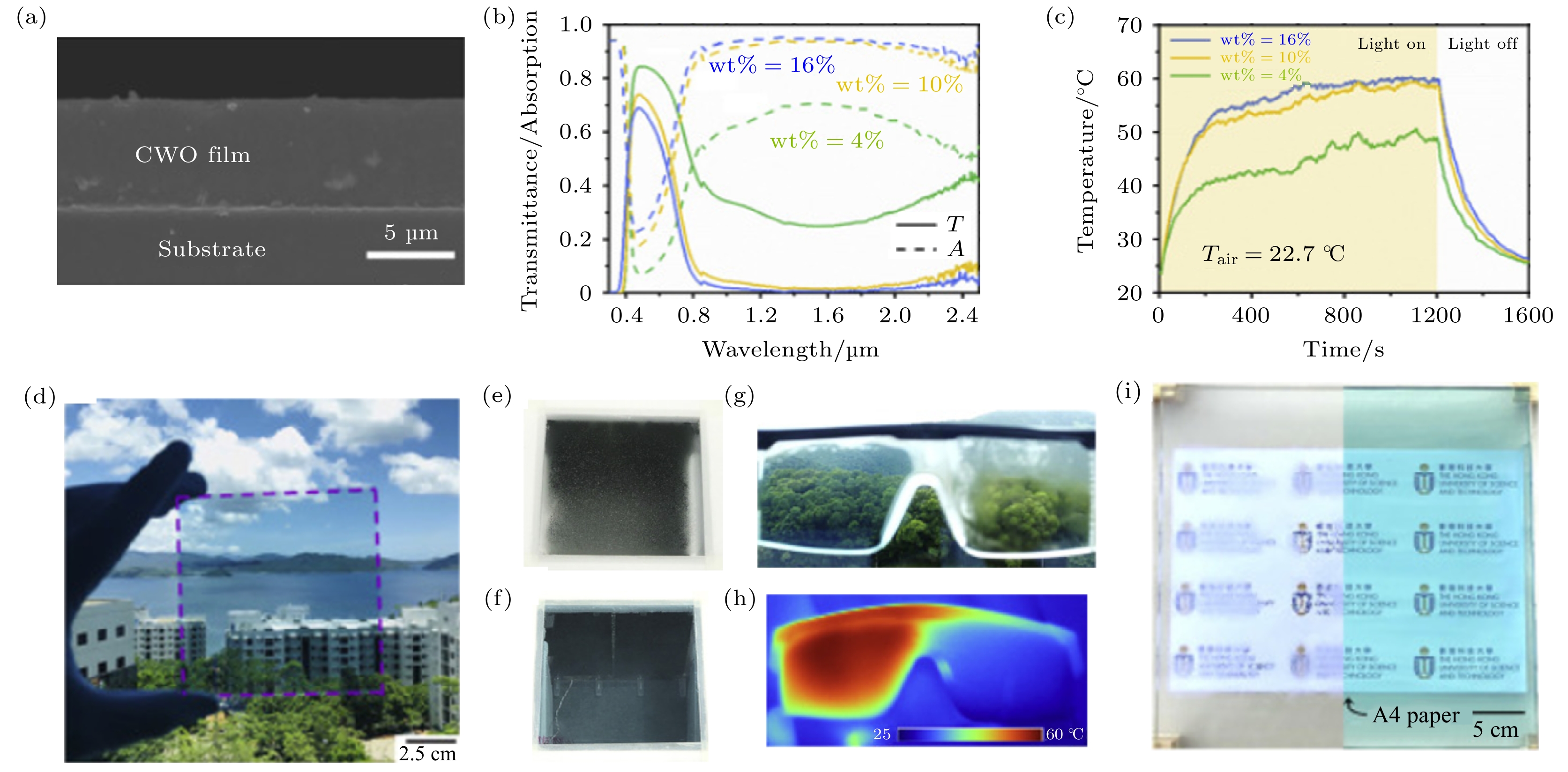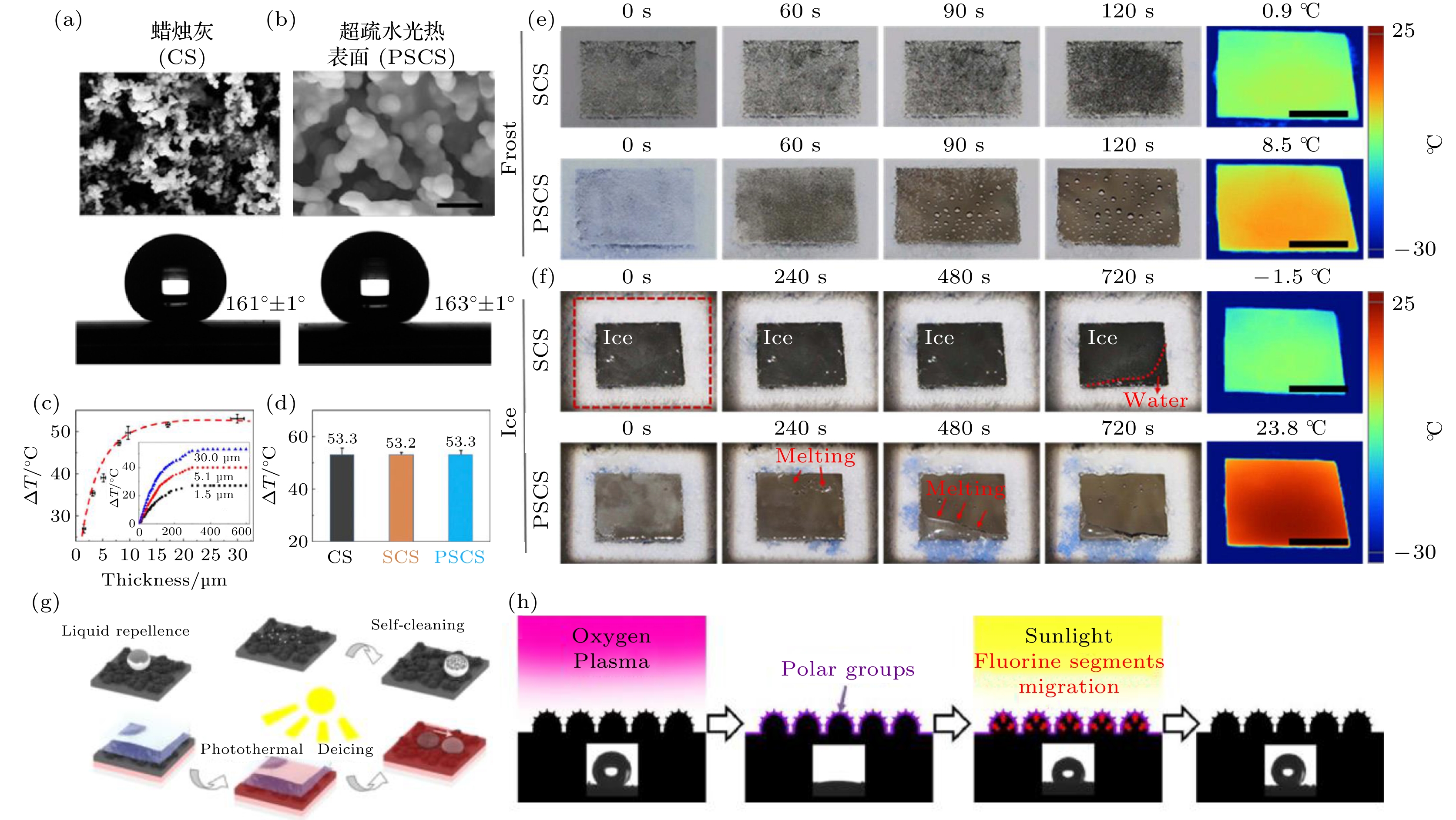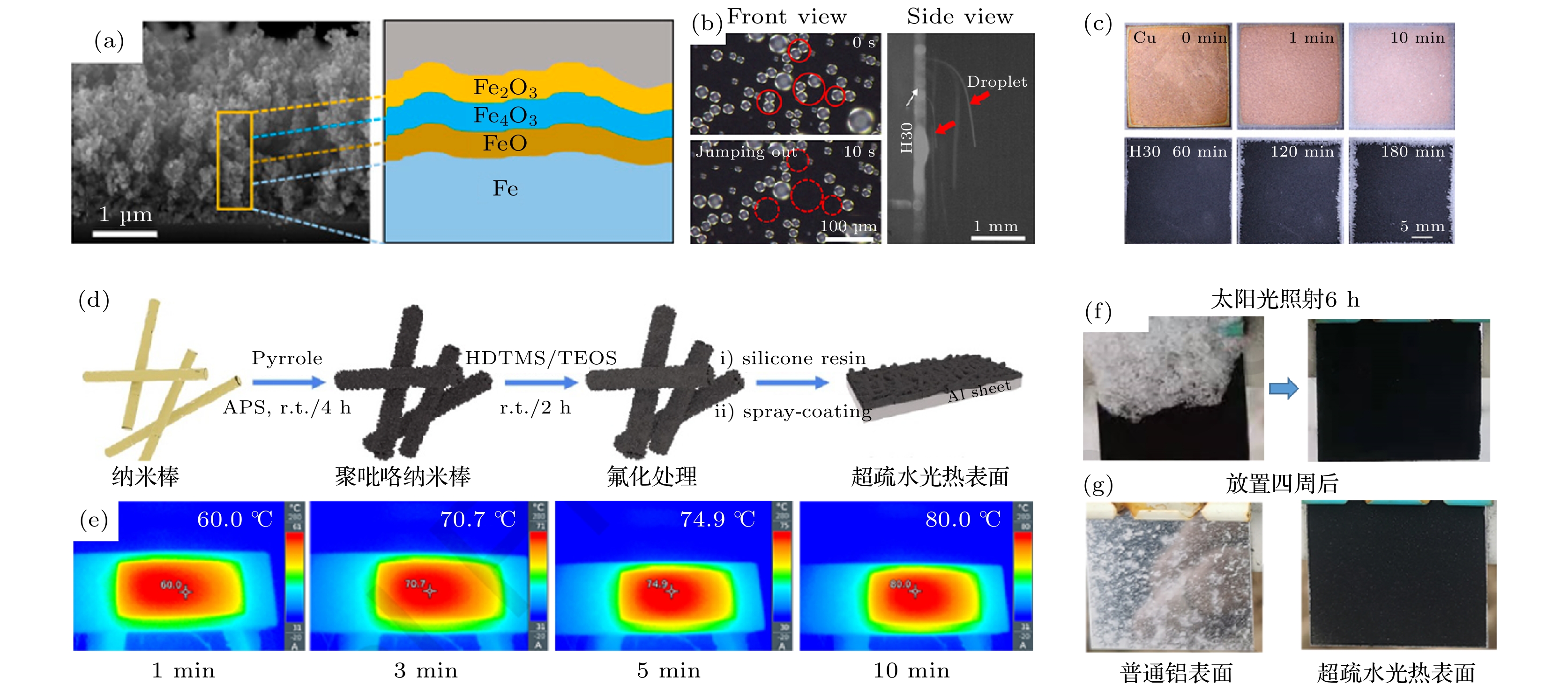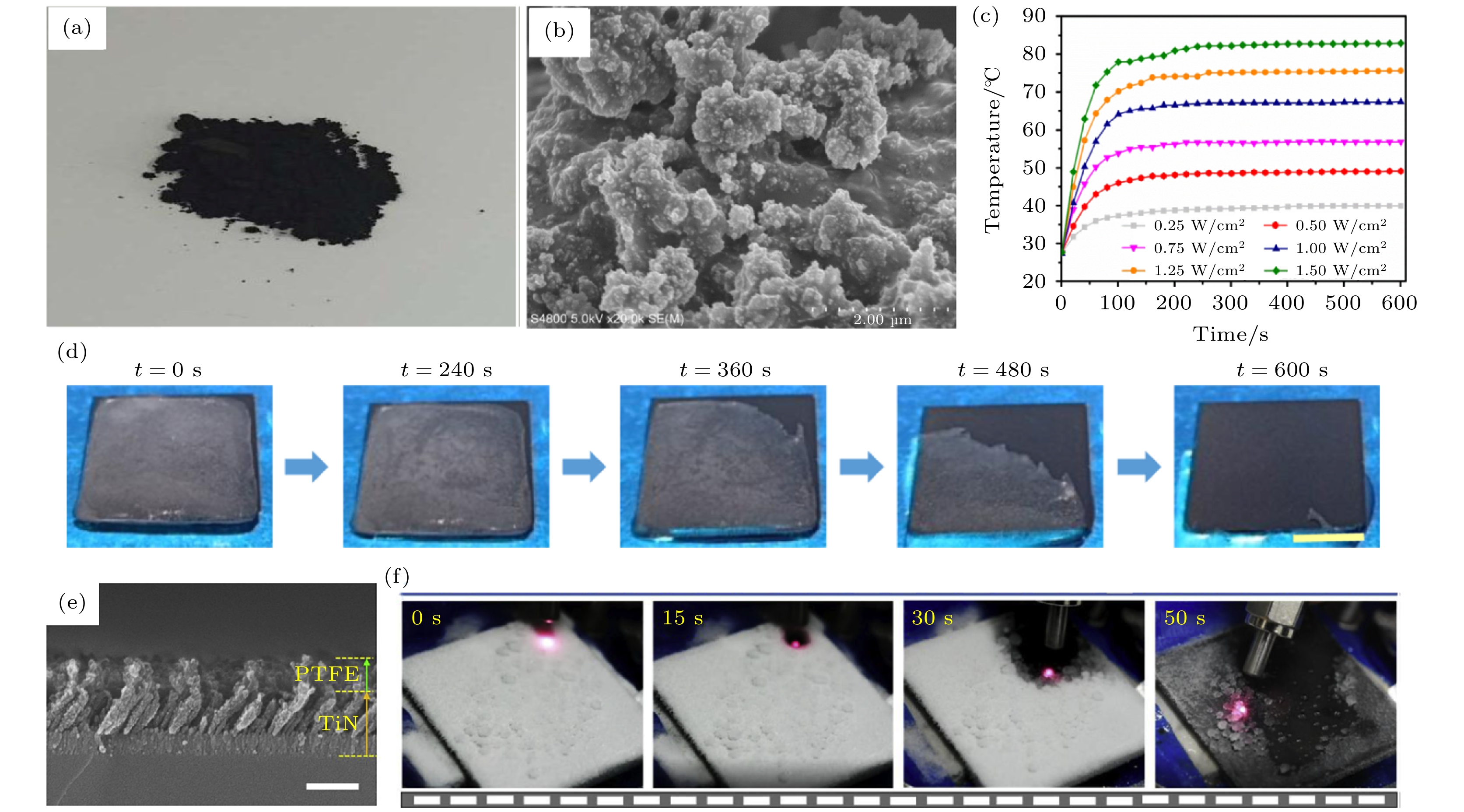-
Icing, frosting, and fogging are all natural phenomena in cold climates, which bring a lot of inconvenience and safety problems to our daily life and industry when formed on the infrastructures. Solar-thermal anti-icing, anti-frosting or anti-fogging surfaces have attracted a lot of interest due to their effectiveness and green ecofriendly features in comparison with the conventional mechanical, thermal, and chemical methods. This short review aims at summarizing the recent progress of solar-thermal anti-fogging/anti-icing/anti-frosting surfaces. First of all, both the fundamental of solar-thermal energy conversion and the mechanism of solar-thermal anti-fogging/anti-icing/anti-frosting are introduced. After that, recent advances in solar-thermal anti-fogging surfaces, and superhydrophobic solar-thermal anti-icing/anti-frosting surfaces are summarized according to the categories of photothermal materials. The results of our collaborative research groups in this field are highlighted in this review. In the end, through comparing those reported surfaces, we point out the bottlenecks in the existing researches of this field, and suggest the potential significant research directions in the future.
-
Keywords:
- solar-thermal energy conversion /
- anti-icing /
- anti-frosting /
- anti-fogging
[1] Laforte J L, Allaire M A, Laflamme J 1998 Atmos. Res. 46 143
 Google Scholar
Google Scholar
[2] Ramakrishna D M, Viraraghavan T 2005 Water Air Soil Poll. 166 49
 Google Scholar
Google Scholar
[3] He X, Liu A, Hu X, Song M, Duan F, Lan Q, Xiao J, Liu J, Zhang M, Chen Y, Zeng Q 2016 Nanotechnology 27 475709
 Google Scholar
Google Scholar
[4] Boreyko J B, Collier C P 2013 ACS Nano 7 1618
 Google Scholar
Google Scholar
[5] Farhadi S, Farzaneh M, Kulinich S A 2011 Appl. Surf. Sci. 257 6264
 Google Scholar
Google Scholar
[6] Meister K, Ebbinghaus S, Xu Y, Duman J G, DeVries A, Gruebele M, Leitner D M, Havenith M 2013 Proc. Natl. Acad. Sci. USA 110 1617
 Google Scholar
Google Scholar
[7] Yin X Y, Zhang Y, Wang D A, Liu Z L, Liu Y P, Pei X W, Yu B, Zhou F 2015 Adv. Funct. Mater. 25 4237
 Google Scholar
Google Scholar
[8] Kim P, Wong T S, Alvarenga J, Kreder M J, Adorno-Martinez W E, Aizenberg J 2012 ACS Nano 6 6569
 Google Scholar
Google Scholar
[9] Ma W, Li Y, Chao C Y H, Tso C Y, Huang B, Li W, Yao S 2021 Cell. Rep. Phys. Sci. 2 100384
 Google Scholar
Google Scholar
[10] Zhang H Q, Zhao G L, Wu S W, Alsaid Y, Zhao W Z, Yan X, Liu L, Zou G S, Lv J Y, He X M, He Z Y, Wang J J 2021 Proc. Natl. Acad. Sci. USA 118 e2100978118
 Google Scholar
Google Scholar
[11] Li W, Lin C, Ma W, Li Y, Chu F, Huang B, Yao S 2021 Cell Reports Physical Science 2 100435
 Google Scholar
Google Scholar
[12] Gao Y, Wang Z, Ding D, Li W, Ma Y, Hao Y, Zhang H 2019 ES Energy Environ. 5 1
[13] Qin C, Gong H, Sun C, Wu X 2022 Engineered Science 17 224
[14] Li Y, Lin C, Wu Z, Chen Z, Chi C, Cao F, Mei D, Yan H, Tso C Y, Chao C Y H, Huang B 2021 Adv. Mater. 33 2005074
 Google Scholar
Google Scholar
[15] Cao F, McEnaney K, Chen G, Ren Z F 2014 Energy Environ. Sci. 7 1615
 Google Scholar
Google Scholar
[16] Li Y, Lin C J, Huang J Y, Chi C, Huang B L 2021 Glob. Chall. 5 2000058
 Google Scholar
Google Scholar
[17] Wu S W, Du Y J, Alsaid Y, Wu D, Hua M T, Yan Y C, Yao B W, Ma Y F, Zhu X Y, He X M 2020 Proc. Natl. Acad. Sci. USA 117 11240
 Google Scholar
Google Scholar
[18] Liu Y B, Wu Y, Liu Y Z, Xu R N, Liu S J, Zhou F 2020 ACS Appl. Mater. Inter. 12 46981
 Google Scholar
Google Scholar
[19] Xie H, Wei J, Duan S, Zhu Q, Yang Y, Chen K, Zhang J, Li L, Zhang J 2022 Chem. Eng. J. 428 132585
 Google Scholar
Google Scholar
[20] Li Y, Li D Z, Chi C, Huang B L 2017 J. Phys. Chem. C 121 16481
 Google Scholar
Google Scholar
[21] Li Y, Xiong C, Huang H, Peng X, Mei D, Li M, Liu G, Wu M, Zhao T, Huang B 2021 Adv. Mater. 33 2103054
 Google Scholar
Google Scholar
[22] Xue C H, Li H G, Guo X J, Ding Y R, Liu B Y, An Q-F, Zhou Y 2021 Chem. Eng. J. 424 130553
 Google Scholar
Google Scholar
[23] Li Y, Lin C, Zhou D, An Y, Li D, Chi C, Huang H, Yang S, Tso C Y, Chao C Y H, Huang B 2019 Nano Energy 64 103947
 Google Scholar
Google Scholar
[24] Li Y, Li D, Zhou D, Chi C, Yang S, Huang B 2018 Solar RRL 2 1800057
 Google Scholar
Google Scholar
[25] Lin K-T, Lin H, Yang T, Jia B 2020 Nat. Commun. 11 1389
 Google Scholar
Google Scholar
[26] Wu Z X, Xue W H, Liu Y J, Wei D, Wang J, Yin L, Wang Y M, Liu X J, Zhang Q, Cao F 2020 Sol. Energy 202 115
 Google Scholar
Google Scholar
[27] Jonsson G, Tordera D, Pakizeh T, Jaysankar M, Miljkovic V, Tong L M, Jonsson M P, Dmitriev A 2017 Nano Lett. 17 6766
 Google Scholar
Google Scholar
[28] Walker C, Mitridis E, Kreiner T, Eghlidi H, Schutzius T M, Poulikakos D 2019 Nano Lett. 19 1595
 Google Scholar
Google Scholar
[29] Guo M, Gao L J, Wei Y, Ma Y, Yu J Y, Ding B 2021 Sol. Energy Mater. Sol. Cells 219 110796
 Google Scholar
Google Scholar
[30] Dash S, de Ruiter J, Varanasi K K 2018 Sci. Adv. 4 eaat0127
 Google Scholar
Google Scholar
[31] Mitridis E, Schutzius T M, Sicher A, Hail C U, Eghlidi H, Poulikakos D 2018 ACS Nano 12 7009
 Google Scholar
Google Scholar
[32] Ma L W, Wang J K, Zhao F T, Wu D Q, Huan Y, Zhang D W, Zhang Z J, Fu W Y, Li X G, Fan Y 2019 Compos. Sci. Technol. 181 107696
 Google Scholar
Google Scholar
-
图 1 (a) 光热超材料的反射(R)、透过 (T) 和吸收(A)光谱; (b)玻璃、染色玻璃和超材料在光照下的温度时间响应; (c)—(e)光照下的防雾表现(c)玻璃、(d)亲水玻璃和(e)光热超材料[28]
Fig. 1. (a) Reflection(R), transmission (T), and absorption (A) spectra of the metasurface; (b) sample temperature increase ΔT, over time t, for the metasurface, tinted laminate, and control glass samples; (c)–(e) antifogging performance enhancement by efficient sunlight absorbing; (c) the contro, (d) hydrophilic, and (e) metasurface. Reproduced from Ref.[28], with the permission of American Chemical Society.
图 2 (a) 防雾表面截面图; (b) 不同CWO质量分数的表面光谱: 透过率(T)和吸收率(A); (c) 不同CWO质量分数的表面在1个标准太阳光下的温度响应曲线; (d) 1个10 cm × 10 cm的透明选择性光热表面CWO质量分数: 10%; (e), (f) 大面积样品的户外防雾测试: (e)普通玻璃表面和(f)光热玻璃表面. 太阳光强: 0.9 kW·m–2; (g), (h) 光热表面(左侧)和未处理表面(右侧)在眼镜上的防雾效果; (i) 大面积玻璃上的防雾效果对比(30 cm×30 cm)[11]
Fig. 2. (a) Cross-sectional SEM image of the as-fabricated coating; (b) transmittance (T) and absorption (A) spectra of the coating with various mass fraction of CWO NPs; (c) temperature responses of the coating with various mass fraction under 1-sun illumination; (d) a 10 cm × 10 cm transparent selective photothermal coating fabricated on a glass substrate. The mass fraction of CWO NPs is kept at 10%; (e), (f) outdoor antifogging test of the large-scale (e) control and (f) photothermal samples using a homemade freezing chamber. The solar intensity was 0.9 kW·m–2; (g), (h) antifogging demonstration (g) and (h) temperature response of a pair of safety goggles (left side: treated, right side: untreated); (i) anti-fogging demonstration of a 30 cm × 30 cm glass substrate (left side: untreated, right side: treated). Reproduced from Ref.[11], with the permission of the authors.
图 3 (a), (b) 蜡烛灰(CS)和超疏水光热表面(PSCS)的SEM和接触角图片[17]; (c)不同厚度的蜡烛灰在1个太阳光照下的温升曲线[17]; (d) 蜡烛灰, 亲水光热表面和超疏水光热表面在300 s阳光照射后的温升对比[17]; (e)亲水和超疏水光热表面在1个太阳光下的除霜实验[17]; (f)亲水和超疏水光热表面在1个太阳光下的除冰实验[17]; (g) 喷涂法制备超疏水除冰光热表面的原理图[18]; (h)光热表面超疏水性自修复机理[18]
Fig. 3. (a), (b) SEM images and water contact angle of the structures of CS and PSCS; (c) temperature increases of surface under 1 sun[17]; (d) temperature increases of CS SCS and PSCS after illumination under 1 sun for 300 s, photothermally induced melting of frost and ice on SCS and PSCS surfaces under 1-sun illumination[17]; (e) the melting of frost on the superhydrophilic SCS surface and superhydrophobic PSCS surface (A2)[17]; (f) the melting of ice on the superhydrophilic SCS surfaces and superhydrophobic PSCS surface (Reproduced from Ref. [17], with the permission of United States National Academy of Sciences); (g) photothermal ice removal performance[18]; (h) superhydrophobicity self-recovery mechanism of the photothermal coating. Reproduced from Ref.[18], with the permission of American Chemical Society.
图 4 (a) CR-SASs截面图和它的成分组成[10]; (b) 冷凝液滴在超疏水光热表面上可以持续性的合并-弹跳最终脱离表面; (c) 在低温高湿的条件下铜和CR-SASs的防霜效果对比[10]; (d) 超疏水黑色聚合物表面制备流程图[19]; (e) 超疏水黑色聚合物表面的温度-时间变化图[19]; (f) 超疏水黑色聚合物表面在太阳光照射6 h后融雪[19]; (g) 普通铝表面和超疏水黑色聚合物表面放置四周后表面的防尘效果对比[19]
Fig. 4. (a) Side-view images of CR-SASs and their surface composition[10]; (b) condensed droplets can be continuously removed from CR-SASs through coalesced droplet jumping[10]; (c) long-period photothermal experiment under the low-temperature and high-humidity condition for Cu and CR-SASs (Reproduced from Ref.[10], with the permission of United States National Academy of Sciences); (d) schematic preparation of the PPY/Attpulgite photothermal superhydrophobic coatings[19]; (e) PPY photothermal superhydrophobic at certain time intervals[19]; (f) active deicing test of PPY photothermal superhydrophobic surface[19]; (g) PPY photothermal superhydrophobic surface and aluminum sheets after outdoor exposure for 4 weeks. Reproduced from Ref.[19], with the permission of Elsevier.
图 5 (a) 提取出的墨鱼黑色素粉末[22]; (b) 超疏水光热表面的SEM照片[22]; (c) 在不同太阳光强度下的温升曲线[22]; (d) 在1个太阳光下超疏水光热表面的除冰过程[22]; (e) 氮化钛-聚四氟乙烯截面图[32]; (f) 氮化钛-聚四氟乙烯光热表面的激光除冰过程[32]
Fig. 5. (a) Digital photograph of the powder of melanin nanoparticles[22]; (b) SEM image of superhydrophobic photothermal coating[22]; (c) Photothermal-heating curves of the superhydrophobic photothermal coating at different sunlight intensity[22]; (d) optical images of photothermal deicing process on superhydrophobic photothermal coating under one sun irradiation(Reproduced from Ref.[22], with the permission of Elsevier); (e) cross-sectional SEM images of the TiN-PTFE film[32]; (f) optical images of photothermal deicing processes on TiN-PTFE surface. Reproduced from Ref. [32], with the permission of Elsevier.
图 6 (a) 超疏水选择性光热表面(SHSSA)的SEM与接触角图片; (b) 超疏水选择性光热表面(SHSSA), 选择性光热表面(SSA)和超疏水黑体(SHB)的紫外-可见光-红外吸收光谱; (c) SHSSA, SSA, 和 SHB 在1个太阳光照下的温度-时间变化; (d) 5 μL液滴在环境温度稳定在零下60 ℃时在太阳光照下的结冰过程; (e) 在1个太阳光照下的SHSSA的融冰过程; (f)在1个太阳光照下SHSSA的融霜过程[9]
Fig. 6. (a) SEM and contact angle measurement images of SHSSA; (b) UV-visible-IR absorptance spectra of SHSSA SSA and SHB; (c) temperature increases (ΔT) of SHSSA, SSA, and SHB as a function of time under 1-sun illumination; (d) freezing process of a 5-μL droplet when the chamber temperature was adjusted to –60 °C. Time-zero is defined as the moment when the temperature reaches to the set temperature; (e) top-view image sequences showing the deicing process under 1-sun illumination on the SHSSA surface; (f) top-view image sequences showing the defrosting process under 1-sun illumination on the SHSSA surface. Reproduced from Ref. [9], with the permission of the authors.
-
[1] Laforte J L, Allaire M A, Laflamme J 1998 Atmos. Res. 46 143
 Google Scholar
Google Scholar
[2] Ramakrishna D M, Viraraghavan T 2005 Water Air Soil Poll. 166 49
 Google Scholar
Google Scholar
[3] He X, Liu A, Hu X, Song M, Duan F, Lan Q, Xiao J, Liu J, Zhang M, Chen Y, Zeng Q 2016 Nanotechnology 27 475709
 Google Scholar
Google Scholar
[4] Boreyko J B, Collier C P 2013 ACS Nano 7 1618
 Google Scholar
Google Scholar
[5] Farhadi S, Farzaneh M, Kulinich S A 2011 Appl. Surf. Sci. 257 6264
 Google Scholar
Google Scholar
[6] Meister K, Ebbinghaus S, Xu Y, Duman J G, DeVries A, Gruebele M, Leitner D M, Havenith M 2013 Proc. Natl. Acad. Sci. USA 110 1617
 Google Scholar
Google Scholar
[7] Yin X Y, Zhang Y, Wang D A, Liu Z L, Liu Y P, Pei X W, Yu B, Zhou F 2015 Adv. Funct. Mater. 25 4237
 Google Scholar
Google Scholar
[8] Kim P, Wong T S, Alvarenga J, Kreder M J, Adorno-Martinez W E, Aizenberg J 2012 ACS Nano 6 6569
 Google Scholar
Google Scholar
[9] Ma W, Li Y, Chao C Y H, Tso C Y, Huang B, Li W, Yao S 2021 Cell. Rep. Phys. Sci. 2 100384
 Google Scholar
Google Scholar
[10] Zhang H Q, Zhao G L, Wu S W, Alsaid Y, Zhao W Z, Yan X, Liu L, Zou G S, Lv J Y, He X M, He Z Y, Wang J J 2021 Proc. Natl. Acad. Sci. USA 118 e2100978118
 Google Scholar
Google Scholar
[11] Li W, Lin C, Ma W, Li Y, Chu F, Huang B, Yao S 2021 Cell Reports Physical Science 2 100435
 Google Scholar
Google Scholar
[12] Gao Y, Wang Z, Ding D, Li W, Ma Y, Hao Y, Zhang H 2019 ES Energy Environ. 5 1
[13] Qin C, Gong H, Sun C, Wu X 2022 Engineered Science 17 224
[14] Li Y, Lin C, Wu Z, Chen Z, Chi C, Cao F, Mei D, Yan H, Tso C Y, Chao C Y H, Huang B 2021 Adv. Mater. 33 2005074
 Google Scholar
Google Scholar
[15] Cao F, McEnaney K, Chen G, Ren Z F 2014 Energy Environ. Sci. 7 1615
 Google Scholar
Google Scholar
[16] Li Y, Lin C J, Huang J Y, Chi C, Huang B L 2021 Glob. Chall. 5 2000058
 Google Scholar
Google Scholar
[17] Wu S W, Du Y J, Alsaid Y, Wu D, Hua M T, Yan Y C, Yao B W, Ma Y F, Zhu X Y, He X M 2020 Proc. Natl. Acad. Sci. USA 117 11240
 Google Scholar
Google Scholar
[18] Liu Y B, Wu Y, Liu Y Z, Xu R N, Liu S J, Zhou F 2020 ACS Appl. Mater. Inter. 12 46981
 Google Scholar
Google Scholar
[19] Xie H, Wei J, Duan S, Zhu Q, Yang Y, Chen K, Zhang J, Li L, Zhang J 2022 Chem. Eng. J. 428 132585
 Google Scholar
Google Scholar
[20] Li Y, Li D Z, Chi C, Huang B L 2017 J. Phys. Chem. C 121 16481
 Google Scholar
Google Scholar
[21] Li Y, Xiong C, Huang H, Peng X, Mei D, Li M, Liu G, Wu M, Zhao T, Huang B 2021 Adv. Mater. 33 2103054
 Google Scholar
Google Scholar
[22] Xue C H, Li H G, Guo X J, Ding Y R, Liu B Y, An Q-F, Zhou Y 2021 Chem. Eng. J. 424 130553
 Google Scholar
Google Scholar
[23] Li Y, Lin C, Zhou D, An Y, Li D, Chi C, Huang H, Yang S, Tso C Y, Chao C Y H, Huang B 2019 Nano Energy 64 103947
 Google Scholar
Google Scholar
[24] Li Y, Li D, Zhou D, Chi C, Yang S, Huang B 2018 Solar RRL 2 1800057
 Google Scholar
Google Scholar
[25] Lin K-T, Lin H, Yang T, Jia B 2020 Nat. Commun. 11 1389
 Google Scholar
Google Scholar
[26] Wu Z X, Xue W H, Liu Y J, Wei D, Wang J, Yin L, Wang Y M, Liu X J, Zhang Q, Cao F 2020 Sol. Energy 202 115
 Google Scholar
Google Scholar
[27] Jonsson G, Tordera D, Pakizeh T, Jaysankar M, Miljkovic V, Tong L M, Jonsson M P, Dmitriev A 2017 Nano Lett. 17 6766
 Google Scholar
Google Scholar
[28] Walker C, Mitridis E, Kreiner T, Eghlidi H, Schutzius T M, Poulikakos D 2019 Nano Lett. 19 1595
 Google Scholar
Google Scholar
[29] Guo M, Gao L J, Wei Y, Ma Y, Yu J Y, Ding B 2021 Sol. Energy Mater. Sol. Cells 219 110796
 Google Scholar
Google Scholar
[30] Dash S, de Ruiter J, Varanasi K K 2018 Sci. Adv. 4 eaat0127
 Google Scholar
Google Scholar
[31] Mitridis E, Schutzius T M, Sicher A, Hail C U, Eghlidi H, Poulikakos D 2018 ACS Nano 12 7009
 Google Scholar
Google Scholar
[32] Ma L W, Wang J K, Zhao F T, Wu D Q, Huan Y, Zhang D W, Zhang Z J, Fu W Y, Li X G, Fan Y 2019 Compos. Sci. Technol. 181 107696
 Google Scholar
Google Scholar
计量
- 文章访问数: 12627
- PDF下载量: 322
- 被引次数: 0














 下载:
下载:





